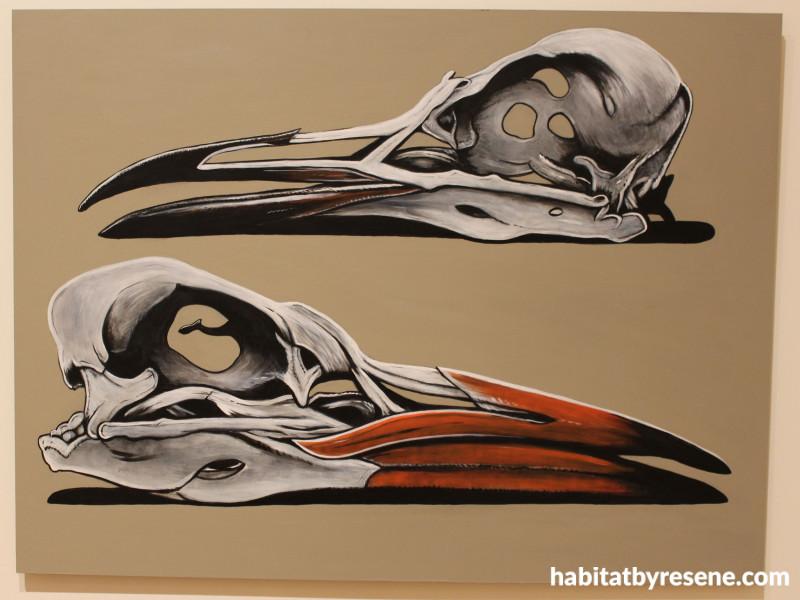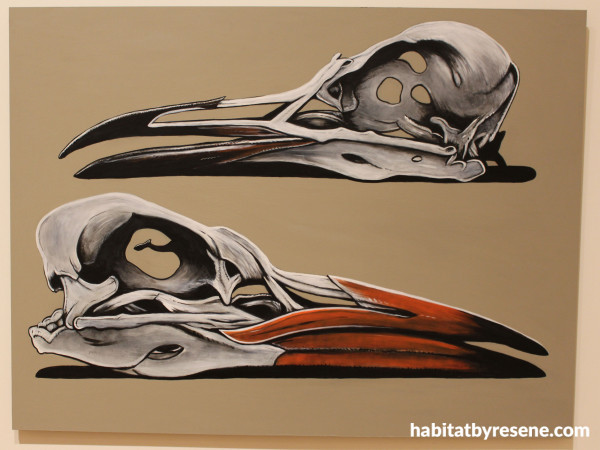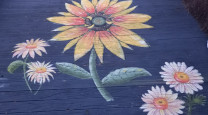
The lovely bones: Artist Bruce Mahalski’s skeletons and skulls intrigue and delight
03 Jun 2021
Museum owner Bruce Mahalski has art in his bones. Quite literally – Bruce, who is not only the owner and director of the Dunedin Museum of Natural Mystery but is also an artist, uses Resene paint, to create larger-than-life paintings of the skeletons of natural specimens.
Bruce’s paintings for ‘Our Evolutionary Past’ exhibition at the Otago Museum use Resene White and Resene Cougar on a striking background painted in Resene Black.
Bruce is a multimedia artist who works with sculpture, paint, and murals. He also runs the Dunedin Museum of Natural Mystery; a museum that focusses on unusual aspects of natural history. Bruce’s work is inspired by his background in science and many of his pieces in the museum’s gallery explore the intersection between science and art. “I am very inspired by the natural world,” says Bruce. “Much of my art focusses on local animals and plants.
“I try to make work that focusses on the ecological consequences of human behaviour.”
A hominid skull from ‘Our Evolutionary Past’ uses a muted palette of Resene Cougar, Resene Black and Resene White.
Bruce hasn’t always been an artist; he began as a clothing maker in the 1980s before working as an illustrator and art teacher in Wellington. He moved to Dunedin in 2017 to open his museum. Bruce has exhibited and sold his work across New Zealand and overseas and has painted over fifty murals using Resene paint.
“I like using Resene paints because they’re very hard wearing and work well on a wide variety of surfaces. There is also a fantastic choice of colours and I have a great relationship with some of the friendly staff.”
This hominid skull uses Bruce’s go-to colour palette of Resene Black, Resene White and Resene Cougar with a pop of brown Resene Mai Tai.
Bruce uses a pared back colour palette of Resene Black, Resene White and Resene Cougar to let the detail shine. “I try to limit my colour palette for two reasons,” says Bruce. “One, so I can paint quickly and two, so I can make my work more identifiable.
“My favourite colours to work with are Resene Craigieburn and Resene Jalapeno.”
Bruce’s own solo exhibition at the Forrester Gallery, titled ‘Seeds of life, the bone art of Bruce Mahalski,’ features this fur seal artwork painted in Resene Black, Resene White and Resene Cougar with a vibrant background in Resene Jalapeno.
Bruce has recently contributed a series of paintings for the ‘Our Evolutionary Past’ exhibition at Otago Museum. The curators of the museum approached him to create a collection of a dozen paintings featuring the skulls and skeletons of our human ancestors. They provided Bruce with photographs of the specimens and from there he went on to create incredibly detailed artistic versions of the skulls.

One of his favourite colours, Resene Craigieburn provides a windswept rocky brown background for these tern skulls painted in Resene Black, Resene White and Resene Cougar.
This commission inspired him to create a large painted series of animal skulls for his own museum. These paintings are currently on display at Bruce’s solo exhibition in Oamaru’s Forrester Gallery.
Bruce’s love of painting has pushed him to create over fifty murals around New Zealand. This mural was painted in Resene Black, Resene White, Resene Cougar and one of his favourite colours, Resene Jalapeno.
Using Resene paint has given Bruce the opportunity to paint everything from microscopic organisms, such as plankton, to paintings of the Victorian taxidermy animals on display in The Animal Attic at Otago Museum. With a wealth of knowledge in both the sciences and arts, Bruce’s bone art doesn’t focus on death, but instead celebrates the living organisms that have created them.
You can read more about the Our Evolutionary Past exhibition here or see details for Bruce’s solo exhibition here
Click here to see more of Bruce’s wall paintings around Dunedin or view his website
Published: 03 Jun 2021




